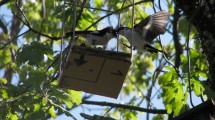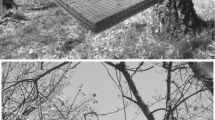Abstract
In monogamous species, conspecific aggression is a primary tactic to deter intruders. Alternative reproductive strategies, such as extra-pair copulations or intra-specific brood parasitism that peak at the pre-egg laying period and are practised by intruders, pose a significant threat to the monogamous pair. Here, we addressed the question whether male and female Palestine Sunbirds (Nectarinia osea) demonstrate different aggression levels toward conspecific intruders during the pre-egg laying period. We further asked whether indirect measures of certainty of paternity affect male aggression toward such intruders. For that, we measured the aggression of both partners toward intruders while using stuffed birds. We conducted two experiments on a monogamous and territorial Palestine Sunbird population. In the first experiment, we exposed breeding pairs to a conspecific or a heterospecific intruder and measured their aggression toward it. During the second experiment, we exposed breeding pairs to an intruder, before and after temporarily removing the local male. The local male demonstrated higher aggression than the local female toward a male decoy. Toward a female decoy, the local male demonstrated lower aggression than the local female. Following their release, the removed males did not change their aggression toward the male decoy, but rather they decreased their aggression toward the female decoy. These results suggest that the indirect male’s certainty of paternity may be an important factor of the male’s interests when he faces a risk of potential intra-specific brood parasitism. Furthermore, these findings suggest that each gender is more sensitive to its similar intruder gender, and acts according to its interests in terms of its aggression toward the intruder.
Zusammenfassung
Die Wirkung von Eindringlingen auf territoriale Jerichonektarvögel ( Nectarinia osea ) vor der Eiablage
Bei monogam lebenden Vögeln ist Aggression unter Artgenossen eine primäre Taktik, um Eindringlinge abzuwehren. Alternative reproduktive Strategien, wie zusätzliche Kopulationen oder intra-spezifischer Brutparasitismus, die vor allem vor der Eiablage durch Konkurrenten praktiziert werden, stellen eine erhebliche Bedrohung für den Bruterfolg des monogamen Paares dar. In diesem Kontext stellten wir die Frage, ob männliche und weibliche Jerichonektarvögel (Nectarinia osea) verschieden hohe Aggressionslevel gegenüber eindringenden Artgenossen vor der Eiablage zeigen. Weiterhin fragten wir uns, ob eine indirekte Abschätzung der Gefahr einer Fremdvaterschaft durch die Männchen deren Aggression gegen solche Eindringlinge beeinflusst. Dafür haben wir den Aggressionslevel der beiden Partner auf Eindringlinge mit Hilfe präparierter Vögel beobachtet. Es wurden zwei Experimente an einer monogamen, territorialen Jerichonektarvogel-Population durchgeführt. Im ersten Experiment konfrontierten wir Brutpaare mit einem Artgenossen oder artfremden Eindringling und bestimmten ihre Aggression gegen ihn. Im zweiten Experiment setzten wir den Brutpaaren einen Eindringling vor, wobei das Männchen des Paares temporär entfernt und wieder dazu gesetzt und die Aggressionen beider Partner bestimmt wurde. Die Männchen der untersuchten Paare demonstrierten eine höhere Aggression als die weiblichen Partner gegenüber einem männlichen Lockvogel. Gegen einen weiblichen Lockvogel verhielten sich die Männchen allerdings weniger aggressiv als die Weiblichen. Nachdem die entfernten Männchen dem Versuch wieder zugefügt wurden, hatte sich ihre Aggression gegenüber dem männlichen Eindringling nicht geändert, dem weiblichen Lockvogel gegenüber waren sie aber noch weniger aggressiv. Diese Ergebnisse legen nahe, dass das Risiko einer Fremdvaterschaft eine wichtige Triebkraft im Verhalten der Männchen ist, wenn sie der Gefahr eines möglichen intra-spezifischen Brutparasitismus gegenüber stehen. Darüber hinaus zeigen unsere Ergebnisse, dass jedes Geschlecht sensibler auf Eindringling desselben Geschlechts reagiert, und sich entsprechend seiner Interessen in Bezug auf seine Aggression gegen Eindringlinge verhält.



Similar content being viewed by others
References
Alves MAS, Bryant DM (1998) Brood parasitism in the sand martin, Riparia riparia: evidence for two parasitic strategies in a colonial passerine. Anim Behav 56:1323–1331
Armstrong DP (1992) Correlation between nectar supply and aggression in territorial honeyeaters: causation or coincidence. Behav Ecol Sociobiol 30:95–102
Bennett PM, Owens IPF (2002) Evolutionary ecology of birds. Oxford University Press, Oxford
Brown JL (1964) The evolution of diversity in avian territorial system. Wilson Bull 76:160–169
Chuang-Dobbs HC, Webster MS, Holmes RT (2001) The effectiveness of mate guarding by male black-throated blue warblers. Behav Ecol 12:541–546
Dixon A, Ross D, O’malley SLC, Burk T (1994) Paternal investment inversely related to degree of extra-pair paternity in the reed bunting. Nature 371:698–700
Eliassen S, Kokko H (2008) Current analyses do not resolve whether extra-pair paternity is male or female driven. Behav Ecol Sociobiol 62:1795–1804
Gowaty PA (1981) Aggression of breeding Eastern Bluebird (Sialia sialis) toward their mates and models of intra- and interspecific intruders. Anim Behav 29:1013–1027
Griffith SC, Owens IPF, Thuman KA (2002) Extra pair paternity in birds: a review of interspecific variation and adaptive function. Mol Ecol 11:2195–2212
Griffith SC, Lyon BE, Montgomerie R (2004) Quasi-parasitism in birds. Behav Ecol Sociobiol 56:191–200
Harrison C (1975) A field guide to the nests, eggs and nestlings of British and European birds. Collins, London
Johnsen A, Pärn H, Fossøy F, Kleven O, Laskemoen T, Lifjeld JT (2008) Is female promiscuity constrained by the presence of her social mate? An experiment with bluethroats Luscinia svecica. Behav Ecol Sociobiol 62:1761–1767
Kleiber D, Kyle K, Rockwell SM, Dickinson JL (2007) Sexual competition explains patterns of individual investment in territorial aggression in western bluebird winter groups. Anim Behav 73:763–770
Kokko H (1999) Cuckoldry and the stability of biparental care. Ecol Lett 153:449–463
Komdeur J, Burke T, Richardson DS (2007) Explicit experimental evidence for the effectiveness of proximity as mate-guarding behavior in reducing extra-pair fertilization in the Seychelles warbler. Mol Ecol 16:3679–3688
Lack D (1968) Ecological adaptations for breeding in birds. Methuen, London
Lyon BE, Eadie JM (2008) Conspecific brood parasitism in birds: a life-history perspective. Annu Rev Ecol Evol Syst 39:343–363
Lyon BE, Hochachke WM, Eadie JM (2002) Paternity-parasitism trade-offs: a model and test of host-parasite cooperation in an avian conspecific brood parasite. Evolution 56:1253–1266
Markman S, Yom-Tov Y, Wright J (1995) Male parental care in the orange-tufted sunbird: behavioral adjustments in provisioning and nest guarding effort. Anim Behav 50:655–669
Markman S, Yom-Tov Y, Wright J (1996) The effect of male removal on female parental care in the orange-tufted sunbird. Anim Behav 52:437–444
Markman S, Pinshow B, Wright J (1999) Orange-tufted Sunbirds do not feed nectar to their chicks. Auk 116:257–259
Markman S, Pinshow B, Wright J (2002) The manipulation of food resources reveals sex-specific trade-off between parental self-feeding and offspring care. Proc R Soc Lond B 269:1931–1938
Markman S, Tadmor-Melamed H, Arieli A, Izhaki I (2006) Sex differences in food intake and digestive constraints in a nectarivorous bird. J Exp Biol 209:1058–1063
McRae SB, Burke T (1996) Intraspecific brood parasitism in the moorhen: parentage and parasite-host relationships determined by DNA fingerprinting. Behav Ecol Sociobiol 38:115–129
Møller AP, Birkhead TR (1991) Frequent copulations and mate guarding as alternative paternity guards in birds: a comparative study. Behaviour 118:170–186
Mougeot F, Arroyo BE, Bretagnolle V (2001) Decoy presentations as a means to manipulate the risk of extrapair copulation: an experimental study in a semicolonial raptor, the Montagu’s harrier (Circus pygargus). Behav Ecol 12:1–7
Petrie M, Møller AP (1991) Laying eggs in others’ nests: intraspecific brood parasitism in birds. Trends Ecol Evol 6:315–320
Petrusková T, Petrusek A, Pavel V, Fuchs R (2007) Territorial meadow pipit males (Anthus pratensis; Passeriformes) become more aggressive in female presence. Naturwissenschaften 94:643–650
Pryke SR (2009) Is red an innate or learned signal of aggression and intimidation? Anim Behav 78:393–398
Scriba M, Goymann W (2008) The decoy matters! Hormonal and behavioral differences in the reaction of territorial European robins towards stuffed and live decoys. Gen Comp Endocrinol 155:511–516
Sheldon BC, Ellegren H (1998) Paternal effort related to experimentally manipulated paternity of male collared flycatchers. Proc R Soc Lond B 265:1737–1742
Slagsvold T (1993) Female-female aggression and monogamy in Great Tits Parus major. Ornis Scand 24:155–158
Southern LK (1981) Sex-related differences in territorial aggression by Ring-billed Gulls. Auk 98:179–181
Trivers RL (1972) Parental investment and sexual selection. In: Campbell B (ed) Sexual selection and the descent of man. Aldine, Chicago, pp 136–179
Westneat DF, Sargent RC (1996) Sex and parenting: the effects of sexual conflict and parentage on parental strategies. Trends Ecol Evol 11:87–91
Westneat DF, Sherman PW, Morton ML (1990) The ecology and evolution of extra-pair copulation in birds. Curr Ornithol 7:331–369
Wrege PH, Emlen ST (1987) Biochemical determination of parental uncertainty in white-fronded bee-eaters. Behav Ecol Sociobiol 20:153–160
Yom-Tov Y (1980) Intraspecific nest parasitism in birds. Biol Rev 55:93–108
Yom-Tov Y (2001) An updated list and some comments on the occurrence of intraspecific nest parasitism in birds. Ibis 143:133–143
Zilberman R (1991) Extra-pair copulation in sunbird population (Nectarinia osea osea) in Ramat-Aviv area. MSc thesis, Tel-Aviv University, Tel-Aviv
Zilberman R (2000) Extra-pair paternity, pair bond and territoriality in the socially monogamous sunbirds, Nectarinia osea osea. PhD thesis, Tel-Aviv University, Tel-Aviv
Zilberman R, Moav B, Yom-Tov Y (1999) Extra-pair paternity in the socially monogamous orange-tufted sunbird (Nectarinia osea osea). Isr J Zool 45:407–421
Acknowledgments
We thank Maria Novosolov for her help during field work. We also thank to Ido Izhaki and Arnon Lotem for their valuable comments on an earlier version of this manuscript. We are grateful to the Natural History Museum at Tel Aviv University for providing the stuffed birds. This study was done with a permission of the Israel Nature and Parks Authority. We declare that the experiments conducted during this study comply with the current laws of Israel.
Conflict of interest
The authors declare that they have no conflict of interest.
Author information
Authors and Affiliations
Corresponding author
Additional information
Communicated by F. Bairlein.
Rights and permissions
About this article
Cite this article
Berger, I., Leshem, Y., Yom-Tov, Y. et al. The effect of intruders on territorial Palestine Sunbirds (Nectarinia osea) during the pre-egg laying period. J Ornithol 155, 291–299 (2014). https://doi.org/10.1007/s10336-013-1017-5
Received:
Revised:
Accepted:
Published:
Issue Date:
DOI: https://doi.org/10.1007/s10336-013-1017-5




